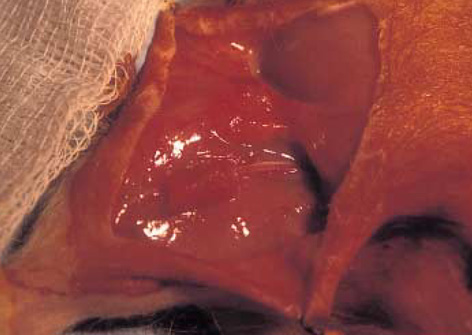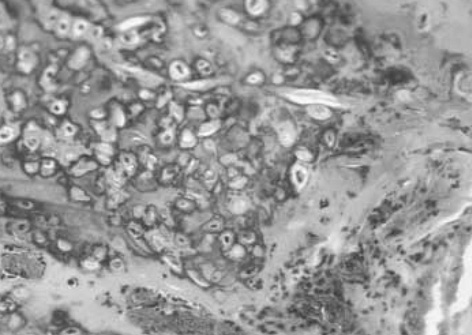J Korean Med Sci.
2005 Jun;20(3):479-482. 10.3346/jkms.2005.20.3.479.
Tissue Engineered Vascularized Bone Formation Using in vivo Implanted Osteoblast-Polyglycolic acid Scaffold
- Affiliations
-
- 1Department of Plastic Surgery, College of Medicine, Chung-Ang University, Seoul, Korea. kimws@cau.ac.kr
- KMID: 1778510
- DOI: http://doi.org/10.3346/jkms.2005.20.3.479
Abstract
- Repair of skeletal defects with vascularized bone grafts has many advantages over non-vascularized free grafts, but the availability of these grafts is extremely limited. This study was designed to determine whether new vascularized bone could be engineered by transplantation of osteoblasts around existing vascular pedicles using biodegradable, synthetic polymer as a cell delivery vehicle. Cells were isolated from the periosteum of fetal bovine humerus, and then seeded onto non-woven multifilament, polyglycolic acid polymer. The polymers provided three dimensional support during in vitro culture. The cell-polymer constructs were maintained in vitro for two weeks and then implanted around the right femoral vessels of twelve athymic nude rats. The polymer templates without the cells were implanted around left femoral vessels of each mouse as a control. Twelve rats were sacrificed at the following intervals: three rats at six, and nine rats at nine weeks. New bone formation was evident in 10 out of the 12 periosteal-derived cell seeded implants. At six weeks, the tissue was primarily composed of what appeared both grossly and histologically to be cartilage enveloping small islands of osteoid. The degree of osteoid and bone formation progressed with time, as blood vessels invaded the tissue. This tissue ultimately underwent morphogenesis to become an organized trabeculated bone with a vascular pedicle. We believe that this technique may prove to be useful in the reconstruction of bony defect.
Keyword
MeSH Terms
Figure
Reference
-
1. Vacanti CA, Kim W, Upton J, Vacanti MP, Mooney D, Schloo B, Vacanti JP. Tissue-engineered growth of bone and cartilage. Transplant Proc. 1993. 25:1019–1021.2. Yoon TR, Jung EJ, Seo HY, Na SJ. In vitro and in vivo osteogenic activity of rabbit periosteum and periosteal cells. J Korean Orthop Res Soc. 2003. 6:238–249.3. Hutmacher DW, Sittinger M. Periosteal cells in bone tissue engineering. Tissue Eng. 2003. 9:Suppl 1. S45–S63.
Article4. Terheyden H, Knak C, Jepsen S, Palmie S, Rueger DR. Mandibular reconstruction with a prefabricated vascularized bone graft using recombinant human osteogenic protein-1. Int J Oral Maxillofac Surg. 2001. 30:373–379.5. Koshihara Y, Kawamura M, Endo S, Tsutsumi C, Kodama H, Oda H, Higaki S. Establishment of human osteoblastic cells derived from periosteum in culture. In Vitro Cell Dev Biol. 1989. 25:37–43.
Article6. Berggren A, Weiland AJ, Dorfman H. Free vascularized bone grafts: Factors affecting their survival and ability to heal to recipient bone defects. Plast Reconstr Surg. 1982. 69:19–29.7. Weiland AJ, Phillips TW, Randolph MA. Radiologic, histologic and biomechanical model comparing autografts, allografts, and free vascularized bone grafts. Plast Reconstr Surg. 1984. 74:368–379.8. Vacanti CA, Langer R, Schloo B, Vacanti JP. Synthetic polymers seeded with chondrocytes provide a template for new cartilage formation. Plast Reconstr Surg. 1991. 88:753–759.
Article9. Kim WS, Vacanti JP, Cima L, Mooney D, Upton J, Puelacher WC, Vacanti CA. Cartilage engineered in predetermined shapes employing cell transplantation on synthetic biodegradable polymers. Plast Reconstr Surg. 1994. 94:233–237.
Article10. Mulliken JB, Glowacki J. Induced osteogenesis for repair and construction in craniofacial region. Plast Reconstr Surg. 1980. 65:553–560.
- Full Text Links
- Actions
-
Cited
- CITED
-
- Close
- Share
- Similar articles
-
- Effects of Induction Culture on Osteogenesis of Scaffold-Free Engineered Tissue for Bone Regeneration Applications
- Development of a Tissue-Engineered Vascular Graft Using Autologous Bone Marrow-Derived Cells and Biodegradable Polymer Scaffold
- Osteogenic Differentiation of Human Adipose-derived Stem Cells within PLGA(Poly(D,L-lactic-co-glycolic acid)) Scaffold in the Nude Mouse
- Prefabrication of Axially Vascularized Bone by Combining β-Tricalciumphosphate, Arteriovenous Loop, and Cell Sheet Technique
- Three-dimensional Culture of Bone Marrow Derived Mesenchymal Stem Cellson Several Scaffolds and Osteogenic Potential of Cell-Scaffold Compositein Vivo





